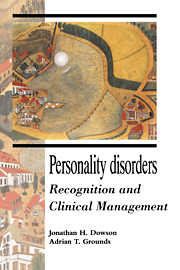9 - Management of offenders with personality disorders
from Part two - Clinical management
Published online by Cambridge University Press: 19 October 2009
Summary
Personality disorders in offender populations
The frequency of PDs amongst people who commit criminal offences is difficult to determine. A high proportion of criminal offences are unreported, and in only a minority of reported cases are the suspects apprehended. Only some of these result in criminal proceedings, and a smaller proportion again will be cautioned or convicted. In the UK it is estimated that only 3% of crimes result in cautions or convictions. Thus, by the time a potentional population of offenders becomes identifiable and accessible for research purposes they are unlikely to be representative of offenders as a whole. Populations of prisoners, on whom most epidemiological research has been carried out, are an even more highly selected group.
Figures from the UK British Crime Survey and from UK annual criminal statistics indicate that about 15 million criminal offences are committed annually in England and Wales with a population of around 50 million, of which half are reported to the police. In 1992, the number of people cautioned or convicted of criminal offences was 1.8 million and the number of people sentenced to imprisonment was 58,000 in 1992 (Home Office, 1993a).
A further difficulty in assessing rates of PD amongst offenders lies in the variety of definitions and research instruments for identifying PD. In offender populations, in whom antisocial behaviour is of particular importance, a variety of diagnostic approaches have been used.
- Type
- Chapter
- Information
- Personality DisordersRecognition and Clinical Management, pp. 321 - 339Publisher: Cambridge University PressPrint publication year: 1995
- 1
- Cited by



